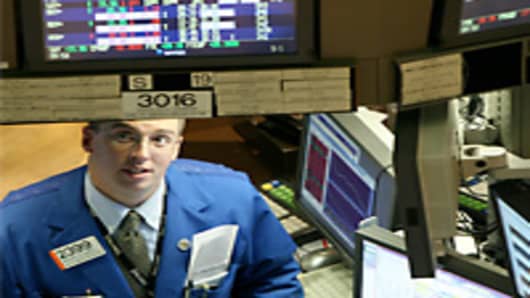After a one-day relief rally, stocks resumed their decline yesterday. Although Tuesday's consumer-spending report beat expectations, it marked the first year-over-year monthly decline since June 2010, as higher gasoline and food prices weighed on Americans.
Then, yesterday, the New York Area General Economic Report dropped to negative 7.8, signaling contraction, as manufacturing slowed. Making matters worse, June's national survey of U.S. homebuilders fell to a nine-month low as the demand outlook weakened.
A negative-data deluge is pushing stock prices to discounts. Although the pace of growth has weakened in recent weeks, corporate America remains healthy, and a soft patch may provide an attractive entry point for equity investors.
It's difficult to buy when others are fleeing the market, but long-term investors should be on the lookout for bargains in both ETFs and equities.
Economic growth is expected by economic researchers and the Fed to pick up in the second half of the year. Even if it misses the consensus 3%-plus rate, a faster rate of expansion will bolster already healthy profits.
Ultimately, the stock market is a mechanism for discounting future corporate profits. With hefty expansion in emerging markets, diversified American corporations have little reason to worry as their prospects remain ideal, even as domestic policy makers struggle to rectify the 1990s debt binge and bloated entitlement spending.
The sooner these issues are resolved, the faster we can return to a sustainable trajectory of expansion and the faster optimism will return to investors. As the saying goes, the market climbs a wall of worry. Pessimism is opportunity.
As Winston Churchill famously stated, "Americans always do the right thing, after they've exhausted every other option." With a debt-ceiling breach looming, it's no longer possible to kick the can down the road, regarding our nation's exorbitant and unsustainable spending.
While Republicans are advocating for deep cuts coupled with lower taxes, other policy makers, including Treasury Secretary Tim Geithner, are pushing tax increases. Federal Reserve Chairman Ben Bernanke, wiggling around his dual mandate last week, argued vehemently for a gradual phasing in of fiscal tightening through steady budget-deficit reduction. Such a plan is least likely to disrupt markets, in his view, while addressing long-term fiscal imbalances.
The ultimate pragmatist, Bernanke also stated that "further monetary easing is warranted." This is perhaps more true than commonly appreciated by the investing consensus. As the G (government spending) in the GDP equation is curtailed, other components, including (I) investment and (X-IM) exports minus imports must rise. Near-zero interest rates and a weak dollar are the tools to spur such an equalizing move.
While Wall Street has long adopted the view that rates won't rise until 2013, it may be even later, depending upon how the economy responds to fiscal right-sizing. A flagging market with lower government spending would be a one-two economic punch. So, the Fed is likely to provide easy money for a while.
In this environment, yield investments are likely to offer steady gains. But, recently, investors have bid up health-care, utility and telecom stocks in recognition of this longer-term trend. With QE2 ending and QE3 politically unfeasible, high-beta growth stocks have gotten slammed as investors sought the safety of income investments.
The yield on the 10-year Treasury bond has dropped beneath 3% numerous times in the past two weeks, signaling a flight to safety. But, as the biggest Treasury buyer, the Fed, steps out of the market, there may be disruption.
The Fed has long argued that the market prices in "stock" not "timing" of asset purchases. In other words, because the Fed clearly signaled how much and over what time frame it would be buying bonds, the market should have a smooth transition when the Fed jumps back into the background. However, financial-market theory has proven to be nonsense, in practice, over the past decade. Investors with significant bond-market exposure may want to consider upping their foreign holdings, or just reducing Treasury exposure, in the next few weeks as QE2 concludes.
While the Dow recently dipped below 11,900, its individual components are, again, falling to attractive historical bargains. The SPDR Dow Jones Industrial Average ETF(DIA) is a safe, diversified way to buy into a rebound in internationally-focused blue chips. The ETF pays a monthly dividend, offering investors the opportunity to compound their bet quickly. The distribution varied quite a bit, but last month's 41 cents, if extended indefinitely, would translate to a 2.3% annualized yield. This ETF merits attention.
Another downtrodden ETF, the Financial Select Sector SPDR (XLF) includes such blue-chip components as JPMorgan (JPM), Wells Fargo (WFC) and Berkshire Hathaway (BRK.B), its largest weightings, at 9.4%, 8.0% and 7.3%, respectively. This ETF offers a steady dividend yield of 1.1%. It has fallen 4.8% in the past six months. Pessimism is ramping up, even in the commodities markets, with oil plummeting as low as $95 a barrel yesterday. These ETFs offer cheap exposure to sectors that are likely to keep healing in the second half of 2011.
______________________________
CNBC Data Pages:
- Dow 30 Stocks—In Real Time
- Oil, Gold, Natural Gas Prices Now
- Where's the US Dollar Today?
- Track Treasury Prices Here
______________________________
Disclosures:
TheStreet's editorial policy prohibits staff editors, reporters and analysts from holding positions in any individual stocks.


